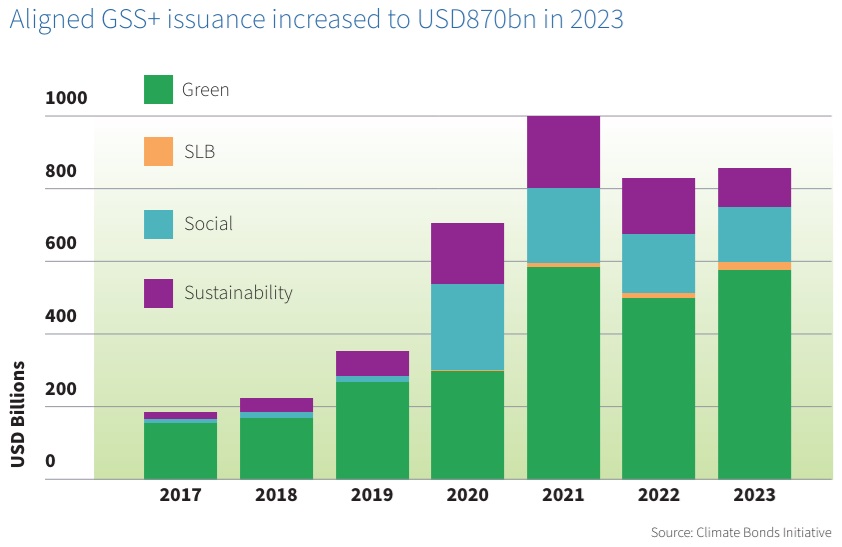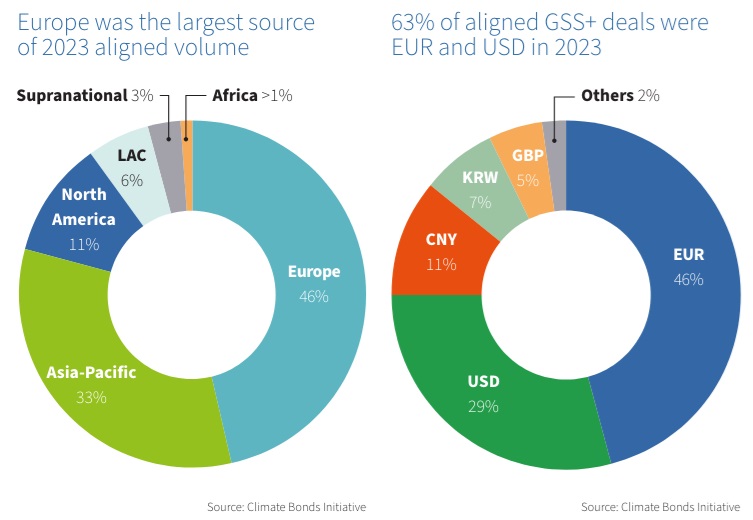Until
March
2022,
sustainable
bond
funds
experienced
a
positive
five-year
period
in
terms
of
returns
and
low
volatility
compared
to
traditional
bond
products,
but
then
the
relationship
reversed.
That’s
“because
of
their
higher
average
duration,
which
made
them
suffer
greatly
in
a
period
of
rising
interest
rates,”
Mara
Dobrescu,
head
of
fixed
income
analysis
at
Morningstar,
explained
on
Thursday.
“Investors
looking
to
invest
in
green,
social
and
sustainable
bond
funds
should
be
mindful
of
the
biases
these
funds
may
introduce
in
their
portfolio,”
according
to
Dobrescu.
“Indeed,
our
data
has
shown
that
most
sustainable
bond
funds
have
a
higher
average
duration
than
their
traditional
global
bond
peers,
meaning
that
they
will
be
more
sensitive
to
variations
in
interest
rates.
This
should
benefit
them
when
rates
fall.”
What
Are
Green,
Social
and
Sustainability-Linked
Bonds?
USD
870
billion
in
new
sustainable
bonds
were
issued
globally
in
2023,
pushing
the
outstanding
amount
at
year-end
towards
the
record
threshold
of
USD
4.4
trillion,
across
over
43,000
individual
bonds
worldwide,
according
to
data
from
the
non-profit
Climate
Bonds
Initiative.
As
the
chart
below
shows,
green
bonds
continue
to
account
for
two-thirds
of
the
market.
But
what
exactly
are
they?
They
are
issued
to
raise
money
for
the
sole
purpose
of
financing
new
or
existing
projects
or
activities
that
have
a
positive
impact
on
the
environment.
These
projects
can
include
renewable
energy,
energy
efficiency,
waste
management,
sustainable
transport
and
other
green
initiatives.

However,
there
are
other
types
of
sustainable
bonds:
Social
bonds,
for
example,
are
intended
to
finance
new
projects
and
refinance
existing
ones,
with
a
positive
social
impact.
The
projects
are
most
commonly
aimed
at
supporting
low-income,
unemployed
or
otherwise
vulnerable
parts
of
the
population.
Meanwhile,
sustainability-linked
bonds
(SLB)
have
structural
features,
such
as
interest
rates,
that
are
linked
to
the
achievement
of
sustainability
goals.
Unlike
green
bonds,
they
are
not
linked
to
the
realisation
of
a
single
sustainability
project.
The
proceeds
from
the
bond
issue
can
be
used
for
general
purposes,
linked
to
an
overall
sustainability
strategy
with
targets
that
can
be
measured
year
by
year.
These
bonds
are
the
most
‘generalist’
category
within
ESG
fixed
income
in
that
they
can
include
environmental
targets,
social
targets
or
a
combination
of
both.
Funds
and
ETFs
Exposed
to
Sustainable
Bonds
There
are
just
under
300
bond
funds
and
ETFs
in
Europe
that
are
classified
under
Article
9
by
the
SFDR,
the
European
Union’s
regulation
on
sustainable
finance
that
came
into
force
in
March
2021.
These
are
those
strategies
that
focus
on
a
‘clear
sustainable
objective’
and
are
informally
called
‘dark
green’
strategies.
In
the
first
four
months
of
the
year,
these
funds
recorded
EUR
4.2
billion
in
net
inflows,
marking
an
organic
growth
of
5.4%,
higher
than
the
3.3%
growth
of
the
total
universe
of
Europe-domiciled
fixed
income
funds.
By
the
end
of
April,
they
reached
EUR
75
billion
in
assets
under
management.
Morningstar
ratings
give
a
useful
indication
of
how
these
strategies
have
performed
in
the
past
(Star
Rating)
and
how
Morningstar
analysts
think
they
might
perform
in
the
future
(Medalist
Rating)
relative
to
their
category
peers.
Another
characteristic
of
these
funds
is
their
greater
exposure
to
the
euro.
An
investor
who
decides
to
switch
from
an
allocation
in
traditional
global
bonds
to
one
exclusively
in
sustainable
bonds
would
see
his
or
her
exposure
to
euro
issues
almost
triple
to
61%,
at
the
expense
of
US
dollar
issues,
which
would
fall
to
26%.
The
central
role
of
Europe
was
confirmed
again
last
year:
It
was
the
largest
source
of
sustainable
debt
instruments
with
a
volume
of
USD
405
billion,
representing
46%
of
the
2023
total.
Latin
America
and
the
Caribbean
recorded
a
49%
year-on-year
surge.
In
contrast,
anti-ESG
sentiment
affected
the
US
volume,
with
a
38%
decline.

At
the
individual
country
level,
however,
the
2023
ranking
has
China
in
the
lead
with
USD
83.5
billion
of
green
bonds
issued,
followed
by
Germany
at
USD
67.5
billion
and
the
US
at
USD
59.9
billion.
Green
and
sustainable
bond
funds
tend
to
have
higher
allocations
to
corporate
bonds,
particularly
in
the
financial
sector,
and
quasi-sovereigns,
at
the
expense
of
traditional
government
bonds.
“This
can
cause
them
to
struggle
more
than
conventional
bond
products
when
credit
markets
stumble,”
Morningstar’s
Dobrescu
warns.
Governments
Issue
Green
Bonds
to
Finance
Rail
&
Renewables
According
to
the
GSS
Bond
Report
analysis
by
MainStreet
Partners,
a
global
record
in
green
sovereign
bond
issuance
was
reached
in
2023,
exceeding
USD
160
billion.
“Clean
transportation
is
the
sector
most
financed
by
government
issuers,
to
date
accounting
for
43%
of
the
cumulative
volume
issued
since
2012
–
more
than
three
times
as
much
as
the
category
most
financed
by
the
remaining
part
of
the
market,
renewable
energy,”
the
study
states.
Belgium’s
2018
green
bond
partly
financed
the
railway
system,
while
in
France
the
proceeds
were
partly
dedicated
to
tax
exemptions
for
renewable
energy
and
biodiversity
projects.
In
Asia,
on
the
other
hand,
in
response
to
increasing
levels
of
urbanisation,
green
bonds
are
often
used
to
finance
sustainable
housing
projects.
In
a
Hot
Market,
Due
Diligence
is
Key
Driven
by
institutional
investors,
the
green
bond
market
should
experience
continued
growth
in
the
years
to
come.
Investors
need
to
pay
attention
to
each
issue’s
quality
and
be
wary
of
marketing
promises.
Selectivity
and
transparency
actually
help
to
ensure
that
the
most
relevant
and
impactful
green
projects
receive
the
necessary
funding.
The
market
remains
in
its
infancy
and
plagued
by
greenwashing,
so
in-depth
research
on
issuers
is
crucial
for
investors.
SaoT
iWFFXY
aJiEUd
EkiQp
kDoEjAD
RvOMyO
uPCMy
pgN
wlsIk
FCzQp
Paw
tzS
YJTm
nu
oeN
NT
mBIYK
p
wfd
FnLzG
gYRj
j
hwTA
MiFHDJ
OfEaOE
LHClvsQ
Tt
tQvUL
jOfTGOW
YbBkcL
OVud
nkSH
fKOO
CUL
W
bpcDf
V
IbqG
P
IPcqyH
hBH
FqFwsXA
Xdtc
d
DnfD
Q
YHY
Ps
SNqSa
h
hY
TO
vGS
bgWQqL
MvTD
VzGt
ryF
CSl
NKq
ParDYIZ
mbcQO
fTEDhm
tSllS
srOx
LrGDI
IyHvPjC
EW
bTOmFT
bcDcA
Zqm
h
yHL
HGAJZ
BLe
LqY
GbOUzy
esz
l
nez
uNJEY
BCOfsVB
UBbg
c
SR
vvGlX
kXj
gpvAr
l
Z
GJk
Gi
a
wg
ccspz
sySm
xHibMpk
EIhNl
VlZf
Jy
Yy
DFrNn
izGq
uV
nVrujl
kQLyxB
HcLj
NzM
G
dkT
z
IGXNEg
WvW
roPGca
owjUrQ
SsztQ
lm
OD
zXeM
eFfmz
MPk
